How to build a "super" AM antenna
(These plans have been used by many people, with good results.)
Usually, portables and small table radios work best. If you live in an area where our signal is weak, this antenna COULD make it sound as clear as a local station! This antenna has been used with "cheap" radios to bring in stations which were totally inaudible, even to a good radio. The results can be quite impressive.
Note: This antenna only works with AM.
Page last updated: 3/11/2018
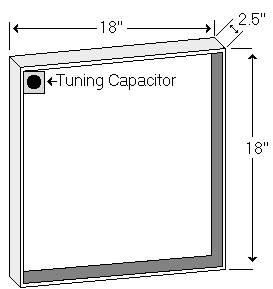 |
The FRAME can be made of any non-metal material: Wood, styrofoam, plastic, cardboard, Etc. The dimensions given are only approximate... adjust as needed. You can make use of almost anything that is on-hand. Depending on what you have for materials, it is possible to build this antenna without spending a dime! (Several have been built using the square styrofoam packing material from various shipping boxes.) |
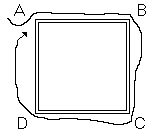 |
Begin by wrapping wire around the frame, A-B-C-D back to "A" 12-18 times. The loose ends will be connected to a TUNING CAPACITOR. The wire should be somewhat tight against the frame. Bascially, ANY diameter of wire may be used, from 30 guage up to at least 18, although it becomes awkward to work with at either extreme. 24 guage seems to be the best to work with. You can use regular insulated or enamelled. The wire is not very critical.
Note: Here is a link to a site that will calculate the MilliHenries of the coil. You want to be around 250 for a standard AM tuning cap to cover the band. Coil Calculator link. This way, you can figure out the exact number of turns you need for the size of the coil you're making. |
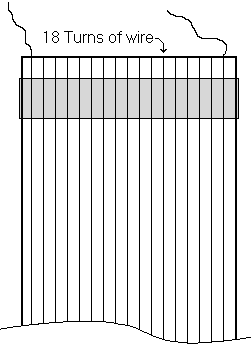 |
Once you are done with the winding, the wire should be taped or glued down at each corner, as represented by the gray area in this diagram. (Tape is recommended until the proper number of turns is determined.) The actual number of turns may need to be changed, depending on the size of the frame. Larger frames need less, smaller need more, you may have to experiment. (Using the calculator link above, will reduce the amount of trial-and-error.) The Tuning Range should cover the AM band: 540 to 1700. More turns brings the range down, (500-1580, for example) less turns brings it up (580-1750). The actual range depends on the range-value of the tuning capacitor and the number of turns turns vs frame size. Normally, combining both sections of a typical AM tuning cap will yeild about 600pf when fully meshed, and about 60 when open. With a 12-turn coil on a 14" frame, this range goes well above and below the typical AM band, so you should have no problem picking up stations. Using a single-section capacitor means you will most likely need to wind 18 turns. Don't be afraid to EXPERIMENT. :)
|
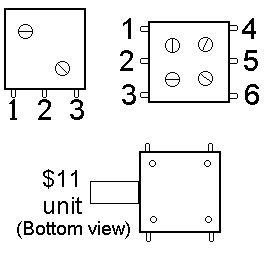 |
The tuning capacitor can be salvaged from a "junk" transistor radio, or purchased from an electronics supply store. The 3-pin type are found in AM-ONLY radios. The 6-pin type are typical in AM/FM units. You will need to examine the radio to determine which terminals you will use. On the 3-pin units, you will always use #2. The other terminal you want is the one which has a wire coming from the radio's built-in antenna coil. (assume it's #1) You would then connect the ends of the wires from the LOOP to terminals 1 &2. With the 6-pin, look for that wire to the coil. You will use that pin, and the center one. (either 2 or 5, whichever is right next to the one with the wire.) You may need to connect pins 1 & 3 together (or 4 & 6 on a 6-pin unit) to get better low-end range. The typical variable value should be in the 30-400 Pf range.
Here is a source for a good tuning capacitor. (About $20) Note that it is somewhat large, but will work just fine. I have purchased several of these, and they are EXCELLENT quality! midnightscience.com
These are single-section caps, and should work fine. There are only two connections, one to the frame, then any one of the four lugs. (All 4 lugs are the same connection point.) |
 |
To use the loop antenna, (light grey box) place it next to the AM radio which has been set to the desired station.(dark grey box) NO CONNECTION IS NEEDED! You may need to rotate the loop from side-to-side, but always keep one side close to the radio. The position of the antenna and the radio will need to be experimented with, as well. This diagram is only a rough guide. This antenna is directional, which can be useful in bringing in the desired station and reducing interference from others. Adjust the tuning capacitor for the loudest & clearest sound. The tuning may be very sensitive, so turn slowly. |
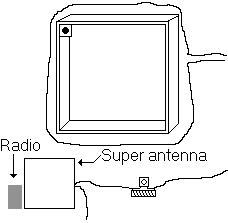 |
* * OPTIONAL * *You can also dramatically increase the sensitivity (but lose directionality) by connecting to an outdoor "longwire" antenna and a cold-water-pipe ground. Add a single turn of wire, and secure it to the frame. One end will connect to the cold water pipe, and the other to the outdoor antenna. If you have another tuning capacitor and you wind a small coil, you can improve the performance even more. 20 to 30 turns of wire around the black "ferrite" piece from the transistor radio's antenna coil will usually work OK. Connect them as shown, in line with the outdoor antenna. (If you don't want to do this, simply connect directly.) *WARNING* Whenever working with ANY outdoor antenna, *ALWAYS* keep it FAR AWAY from any power lines! |
| Photos of 3 completed units |
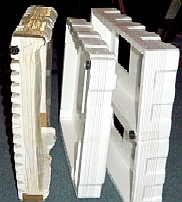 |
 |
Click pictures for larger images. Use BACK button to return here.
These are three units that I made from scrap styrofoam packing material. The unit on the left was about 10-15 years old when I took this pic around 2001. The one on the right was about 10 minutes old. :) All three of them work virtually identically. Unfortunately, the mini tuning capacitors I used in them are no longer sold at Radio Shack... and now, THEY no longer exist! (I had a bunch of them in my parts bin that I used to make these loop antennas. A suitable unit is given in a link, above.)
|
Since a number of folks have asked, "How does it work?", here's a simplified explanation:
It works on a principle of "sympathetic vibration"... like when two guitars are next to each other, and you pluck one string, the corresponding string on the other vibrates.
Here's another explanation: Think of a pendulum. The capacitor and the coil, by themselves, aren't enough. Put them together, and the pendulum will work! The capacitor works a little like the length of the pendulum arm, the coil is the weight... adjusting the capacitor is like moving the weight up and down the arm: it changes the resonant frequency.
Radio waves are, of course, over a million times faster than a pendulum. The electrical energy in the air is picked up by the coil, and it creates a very tiny voltage. That voltage is stored in the capacitor. When the radio wave energy drops, (remember: it is like WAVES-constantly going up and down) the capacitor returns the energy it had stored back into the coil. By the time it has discharged completely, another wave from the station comes along, and repeats the cycle. When the timing of the charge/dischare is exactly the same as the time between waves, it is called "resonance".. the antenna is TUNED to that one specific station. The waves from others will be either too fast or too slow to match the "resonant" frequency of the antenna, so they will not be boosted by much, if at all.
Try holding a yoyo and just swing it. When you move your hand back and forth just a tiny bit at exactly the right speed, that yoyo will swing back and forth quite a bit! If you try moving your hand a little faster or slower, the yoyo may almost completely stop swinging, and it will usually only jiggle. If you return to the right FREQUENCY, it will again resume it's large swinging motion, and as long as you keep moving your hand, it will keep going. This is basically what is happening with the coil & capactitor in this antenna. The tiny radio waves make it "swing" back & forth. As it "swings", it re-emits those radio waves so that a nearby radio picks them up as if the station is a lot stronger! The large size of this loop allows it to gather much more energy than the tiny coil inside the radio.
| TESTIMONIALS!! |
Willie,
I followed your basic plans and built a loop
for AM reception. It works far better than I expected!
It tunes in stations that would otherwise be totally
unreceivable.
I made it for my parents so they could put their radio
inside of the loop if they desired, but I tried it out on
my Radio Shack "emergency" (built in crank/generator)
type radio. I made an oak frame, approx. 21 " square,
then stained and varnished it
It worked out that 9 turns of wire and a 500 mmf
variable capacitor covered the entire broadcast band.
Thanks for all the help on your web site.
Ray A. Shirey |
Please address any E-Mail comments, questions, or suggestions "RE:Antenna" to WILLIE:
Morning1500@AOL.COM







